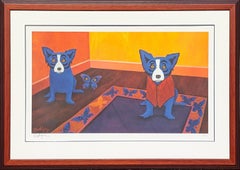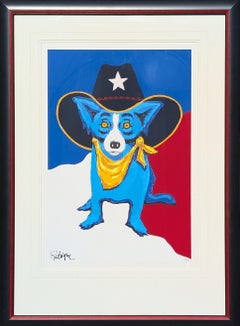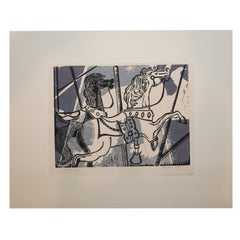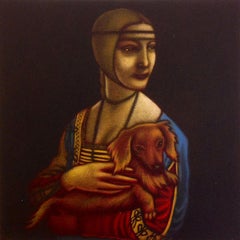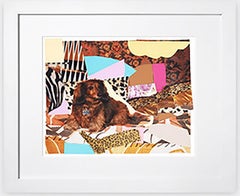Reeves Art + Design Animal Prints
to
3
1
3
2
1
Overall Width
to
Overall Height
to
2
2
2
1
2
1
1
1
1
10
1
1
3
1
3
5
5
2
1
1
1
1
1
1
1
3
3
2
1
1
5
10
"Butterflies Are Free" Contemporary Colorful Blue Dog Silkscreen Ed. 134 / 1000
By George Rodrigue
Located in Houston, TX
Contemporary colorful silkscreen by Louisiana born artist George Rodrigue. The work features a pair of Rodrigue's iconic blue dog characters sitting in a room with a blue butterfly f...
Category
1990s Contemporary Animal Prints
Materials
Screen
"Texas Ranger" Contemporary Blue Dog in Cowboy Hat Silkscreen Ed. 391/800
By George Rodrigue
Located in Houston, TX
Contemporary colorful silkscreen by Louisiana born artist George Rodrigue. The work features Rodrigue's iconic blue dog character dressed in a yellow bandana and a cowboy hat set aga...
Category
1990s Contemporary Animal Prints
Materials
Screen
“Truth is Stranger than Fiction” Black and White Abstract Etching Edition 4/15
By Margaret Smithers Crump
Located in Houston, TX
Black and white abstract etching by Houston artist Margaret Smithers-Crump. The work features a collection of abstracted sea creatures such as a crab, eel, and puffer fish. Signed, t...
Category
1980s Abstract Abstract Prints
Materials
Etching
“Ghost Riders” Abstract Modern Grey Toned Intertwined Snail Screen Print Ed 9/15
Located in Houston, TX
Abstract modern screen print of a pair of intertwining snails floating against a grey toned ombre background. Signed, titled, and editioned along the lower edge of the print. Current...
Category
1990s Abstract Animal Prints
Materials
Screen
Naturalistic Modern Texas Bobcat Black and White Animal Wildlife Print
By Charles Beckendorf
Located in Houston, TX
A signed and numbered print of a bobcat from Texas artist Charles Beckendorf. Charles did the original in pencil for this series. The print is displayed in a chrome frame and white m...
Category
1960s Naturalistic Animal Prints
Materials
Paper, Black and White
"Carousel" Blue Abstract Horse Serigraph
By Barbara Maples
Located in Houston, TX
Blue toned serigraph of a carousel with horses. The work is signed and numbered by the artist. It is not framed but comes with a white matte.
Artist Biography:
Barbara Maples...
Category
1950s Modern Figurative Prints
Materials
Lithograph
Owl On Branch Print Edition 92/120
By Kaiko Moti
Located in Houston, TX
Aquatint print of an owl perched on a branch with bright yellow eyes. The work is signed by the artist. It is framed in a wooden frame with a burlap matte.
Artist Biography: Kaiko M...
Category
1970s Naturalistic Animal Prints
Materials
Aquatint
Woodblock Print with a Cat and Birds in a Field
Located in Houston, TX
Japanese woodblock print of a field with a cat and birds. The print is framed in a black frame with a black matte. It is stamped with a red stamp by the artist. The woodblock print is in the style of Kunihiro Amano.
Category
20th Century Modern Figurative Prints
Materials
Woodcut
"Marsupial" Abstract Impressionist Lithograph of a Kangaroo Edition 3 of 4
By Paul Sprohge
Located in Houston, TX
Abstract animal lithograph of a kangaroo. The work is framed in a gold frame with a white matte. It is signed, dated and titled by the artist. Paul Sprohge is a Houston, Texas artist...
Category
1970s Impressionist Animal Prints
Materials
Lithograph
Green Painted Sea Shell Lithograph Edition 33 of 34
By Frances Nail
Located in Houston, TX
Green shell lithograph of a cone shell. Print is edition 33 of 34. Signed and dated by the artist along with titled. Print is framed in a golden frame...
Category
1970s Naturalistic Still-life Prints
Materials
Lithograph
Related Items
Leonardo Da Vinci's Dog, Limited Edition Print, Animal Portrait
By Mychael Barratt
Located in Deddington, GB
Leonardo da Vinci’s Dog by Mychael Barratt [2021]
limited_edition
Silkscreen print on paper
Edition number 100
Image size: H:21.5 cm x W:21.5 cm
Complete Size of Unframed Work: H:40 cm x W:38 cm x D:0.1cm
Sold Unframed
Please note that insitu images are purely an indication of how a piece may look
Leonardo da Vinci's Dog is a limited edition silkscreen print by Mychael Barratt. The work reference's Leonardo da Vinci's old masters artwork: Lady with an Ermin. Barratt's interpretation of da Vinci's famed work is highly accurate and playful with the addition of a dachshund. The piece is part of Mychael Barratt's Artist Dogs and Cats series - all works in this series are really playful and make wonderful diptych's and triptych's for those interested in history of art and the merging of contemporary practice with the history of art.
Mychael Barratt was born in Toronto, Canada, however, considers himself to be a Londoner since arriving for what was supposed to be a two-week stay thirty years ago. He is a narrative artist whose work is steeped in imagery relating to art history, literature, theatre and everything else that overfills his bookshelves. He was an artist in residence for Shakespeare’s Globe Theatre...
Category
21st Century and Contemporary Contemporary Animal Prints
Materials
Silk, Paper, Screen
$386
H 15.75 in W 14.97 in D 0.04 in
Mickalene Thomas, Portrait de Priscilla Le Petit Chien official COA S/N, Framed
By Mickalene Thomas
Located in New York, NY
Mickalene Thomas
Portrait de Priscilla Le Petit Chien, 2012
Pigment print on 100% cotton rag paper
Edition 141/150
Frame included with official COA affixed to the back
Hand numbered ...
Category
2010s Realist Animal Prints
Materials
Laid Paper, Permanent Marker, Digital Pigment
$4,500
H 16 in W 19 in D 1 in
Minnie (Pink Glitter)
By Damien Hirst
Located in Miami, FL
Screenprint in colors with glitter on heavy wove paper. Hand signed in pencil verso, numbered from the edition of 150 verso with artists copyright inkstamp. Published by Other Crite...
Category
2010s Contemporary Abstract Prints
Materials
Screen
Basquiat’s dog, Limited Edition Print, Animal Portrait, Dog art, Modern art
By Mychael Barratt
Located in Deddington, GB
Limited edition print of a black dog in front of its food bowl. Woof, Woof, Woof!
ADDITIONAL INFORMATION:
Original Limited Edition Print by Mychael Barratt
Screen print on Paper
...
Category
2010s Contemporary Animal Prints
Materials
Silk, Paper, Screen
$492
H 15.75 in W 14.97 in D 0.04 in
Alexander Calder Circus Reproduction Lithograph After a Drawing
By (after) Alexander Calder
Located in Surfside, FL
(after) Alexander Calder
"Calder's Circus" offset lithograph on wove paper after drawings by the artist
Published by Art in America and Perls gallery in 1964 (from drawings done in the 1930's)
these range slightly in size but they are all about 13 X 17 inches (with minor variations in size as issued.) These have never been framed. The outer folio is not included just the one lithograph.
James Sweeny from the introduction “The fame of Calder’s circus spread quickly between the years 1927 and 1930. All the Paris art world came to know it. It brought him his first great personal success. But what was more important, the circus also provided the first steps in Calder’s development as an original sculptor”
Clive Gray wrote ”A visit to the studio of Alexander Calder led to the chance discovery of some hundred masterful circus drawings completed over thirty years ago. We publish, for the first time, a choice of sixteen from that group.” With signed introduction by Miro.
These whimsical drawings, done in the style of wire sculpture, include acrobats, clowns, jugglers, trapeeze artists, an elephant, dog and lion. they are great.
Alexander Calder is widely considered to be one of the most important American sculptors of the 20th century. He is best known for his colorful, whimsical abstract public sculptures and his innovative mobiles, kinetic sculptures powered by motors or air currents, which embraced chance in their aesthetic. Born into a family of accomplished artists, Calder's work first gained attention in Paris in the 1930s and was soon championed by the Museum of Modern Art in New York, resulting in a retrospective exhibition in 1943. Major retrospectives were also held at the Solomon R. Guggenheim Museum (1964) and the Museum of Contemporary Art, Chicago (1974). Calder’s work is in many permanent collections, most notably in the Whitney Museum of American Art, but also the Guggenheim Museum; the Museum of Modern Art; the National Gallery of Art, Washington, D.C.; and the Centre Georges Pompidou. He produced many large public works, including .125 (at JFK Airport, 1957), Pittsburgh (Carnegie International prize winner 1958, Pittsburgh International Airport) Spirale (UNESCO in Paris, 1958), Flamingo and Universe (both in Chicago, 1974), and Mountains and Clouds (Hart Senate Office Building, Washington, D.C., 1976). Although primarily known for his sculpture, Calder was a prodigious artist with a restless creative spirit, whose diverse practice included painting and printmaking, miniatures (such as his famous Cirque Calder), children’s book illustrations, theater set design, jewelry design, tapestry and rug works, and political posters. Calder was honored by the US Postal Service with a set of five 32-cent stamps in 1998, and received the Presidential Medal of Freedom, posthumously in 1977, after refusing to receive it from Gerald Ford one year earlier in protest of the Vietnam War.
Calder moved to New York and enrolled at the Art Students League, studying briefly with Thomas Hart Benton, George Luks, Kenneth Hayes Miller, and John Sloan. While a student, he worked for the National Police Gazette where, in 1925, one of his assignments was sketching the Ringling Bros. and Barnum & Bailey Circus. Calder became fascinated with the action of the circus, a theme that would reappear in his later work.
In 1926, Calder moved to Paris, enrolled in the Académie de la Grande Chaumière, and established a studio at 22 rue Daguerre in the Montparnasse Quarter. In June 1929, while traveling by boat from Paris to New York, Calder met his future wife, Louisa James (1905-1996), grandniece of author Henry James and philosopher William James. They married in 1931. While in Paris, Calder met and became friends with a number of avant-garde artists, including Fernand Léger, Jean Arp, and Marcel Duchamp. Cirque Calder (on view at the Whitney Museum of American Art at present) became popular with the Parisian avant-garde. He also invented wire sculpture, or "drawing in space," and in 1929 he had his first solo show of these sculptures in Paris at Galerie Billiet. Hi! (Two Acrobats) in the collection of the Honolulu Museum of Art is an early example of the artist's wire sculpture. The painter Jules Pascin, a friend of Calder's from the cafes of Montparnasse, wrote the preface to the catalog. A visit to Piet Mondrian's studio in 1930, where he was impressed by the environment-as-installation, "shocked" him into fully embracing abstract art, toward which he had already been tending.
Dating from 1931, Calder’s sculptures of discrete movable parts powered by motors were christened “mobiles” by Marcel Duchamp, a French pun meaning both "motion" and "motive." At the same time, Calder was also experimenting with self-supporting, static, abstract sculptures, dubbed "stabiles" by Jean Arp in 1932 to differentiate them from mobiles.
Public commissions increasingly came his way in the 1960s. Notable examples are .125 for JFK Airport in 1957, Spirale for UNESCO in Paris 1958 and Trois disques, commissioned for Expo 67 in Montreal, Quebec, Canada. Calder's largest sculpture at 25.7 meters high was El Sol Rojo, constructed outside the Aztec Stadium for the 1968 Summer Olympics "Cultural Olympiad" events in Mexico City. Many of his public works were commissioned by renowned architects; I.M. Pei commissioned his La Grande Voile (1966), a 25-ton, 40-foot high stabile for the Massachusetts Institute of Technology.
Part of Calder's repertoire includes pivotal stage sets for more than a dozen theatrical productions, including Nucléa, Horizon, and most notably, Martha Graham’s Panorama (1935), a production of the Erik Satie symphonic drama Socrate (1936), and later, Works in Progress (1968).
In addition to sculptures, Calder painted throughout his career, beginning in the early 1920s. He picked up his study of printmaking in 1925, and continued to produce illustrations for books and journals.As Calder’s professional reputation expanded in the late 1940s and 1950s, so did his production of prints. Masses of lithographs based on his gouache paintings hit the market, and deluxe editions of plays, poems, and short stories illustrated with fine art prints by Calder became available for sale.
One of Calder's most celebrated and unconventional undertakings was a commission from Dallas-based Braniff International Airways to paint a full-size Douglas DC-8-62 four-engined jet as a "flying canvas."
Calder created over 2,000 pieces of jewelry over the course of his career, many of them as gifts for friends and relatives. For his lifelong friend Joan Miró, he set a shard of a broken porcelain vessel in a brass ring. Peggy Guggenheim received enormous silver mobile earrings and later commissioned a hammered silver headboard...
Category
1930s American Modern Animal Prints
Materials
Lithograph
Alexander Calder Circus Reproduction Lithograph of a Drawing
By (after) Alexander Calder
Located in Surfside, FL
(after) Alexander Calder
"Calder's Circus" offset lithograph on wove paper a reproduction lithograph after the drawings by the artist
Published by Art in America and Perls gallery in 1964 (from drawings done in the 1930's)
these range slightly in size but they are all about 13 X 17 inches (with minor variations in size as issued.) These have never been framed. The outer folio is not included just the one lithograph.
James Sweeny from the introduction “The fame of Calder’s circus spread quickly between the years 1927 and 1930. All the Paris art world came to know it. It brought him his first great personal success. But what was more important, the circus also provided the first steps in Calder’s development as an original sculptor”
Clive Gray wrote ”A visit to the studio of Alexander Calder led to the chance discovery of some hundred masterful circus drawings completed over thirty years ago. We publish, for the first time, a choice of sixteen from that group.” With signed introduction by Miro.
These whimsical drawings, done in the style of wire sculpture, include acrobats, clowns, jugglers, trapeeze artists, an elephant, dog and lion. they are great.
Alexander Calder is widely considered to be one of the most important American sculptors of the 20th century. He is best known for his colorful, whimsical abstract public sculptures and his innovative mobiles, kinetic sculptures powered by motors or air currents, which embraced chance in their aesthetic. Born into a family of accomplished artists, Calder's work first gained attention in Paris in the 1930s and was soon championed by the Museum of Modern Art in New York, resulting in a retrospective exhibition in 1943. Major retrospectives were also held at the Solomon R. Guggenheim Museum (1964) and the Museum of Contemporary Art, Chicago (1974). Calder’s work is in many permanent collections, most notably in the Whitney Museum of American Art, but also the Guggenheim Museum; the Museum of Modern Art; the National Gallery of Art, Washington, D.C.; and the Centre Georges Pompidou. He produced many large public works, including .125 (at JFK Airport, 1957), Pittsburgh (Carnegie International prize winner 1958, Pittsburgh International Airport) Spirale (UNESCO in Paris, 1958), Flamingo and Universe (both in Chicago, 1974), and Mountains and Clouds (Hart Senate Office Building, Washington, D.C., 1976). Although primarily known for his sculpture, Calder was a prodigious artist with a restless creative spirit, whose diverse practice included painting and printmaking, miniatures (such as his famous Cirque Calder), children’s book illustrations, theater set design, jewelry design, tapestry and rug works, and political posters. Calder was honored by the US Postal Service with a set of five 32-cent stamps in 1998, and received the Presidential Medal of Freedom, posthumously in 1977, after refusing to receive it from Gerald Ford one year earlier in protest of the Vietnam War.
Calder moved to New York and enrolled at the Art Students League, studying briefly with Thomas Hart Benton, George Luks, Kenneth Hayes Miller, and John Sloan. While a student, he worked for the National Police Gazette where, in 1925, one of his assignments was sketching the Ringling Bros. and Barnum & Bailey Circus. Calder became fascinated with the action of the circus, a theme that would reappear in his later work.
In 1926, Calder moved to Paris, enrolled in the Académie de la Grande Chaumière, and established a studio at 22 rue Daguerre in the Montparnasse Quarter. In June 1929, while traveling by boat from Paris to New York, Calder met his future wife, Louisa James (1905-1996), grandniece of author Henry James and philosopher William James. They married in 1931. While in Paris, Calder met and became friends with a number of avant-garde artists, including Fernand Léger, Jean Arp, and Marcel Duchamp. Cirque Calder (on view at the Whitney Museum of American Art at present) became popular with the Parisian avant-garde. He also invented wire sculpture, or "drawing in space," and in 1929 he had his first solo show of these sculptures in Paris at Galerie Billiet. Hi! (Two Acrobats) in the collection of the Honolulu Museum of Art is an early example of the artist's wire sculpture. The painter Jules Pascin, a friend of Calder's from the cafes of Montparnasse, wrote the preface to the catalog. A visit to Piet Mondrian's studio in 1930, where he was impressed by the environment-as-installation, "shocked" him into fully embracing abstract art, toward which he had already been tending.
Dating from 1931, Calder’s sculptures of discrete movable parts powered by motors were christened “mobiles” by Marcel Duchamp, a French pun meaning both "motion" and "motive." At the same time, Calder was also experimenting with self-supporting, static, abstract sculptures, dubbed "stabiles" by Jean Arp in 1932 to differentiate them from mobiles.
Public commissions increasingly came his way in the 1960s. Notable examples are .125 for JFK Airport in 1957, Spirale for UNESCO in Paris 1958 and Trois disques, commissioned for Expo 67 in Montreal, Quebec, Canada. Calder's largest sculpture at 25.7 meters high was El Sol Rojo, constructed outside the Aztec Stadium for the 1968 Summer Olympics "Cultural Olympiad" events in Mexico City. Many of his public works were commissioned by renowned architects; I.M. Pei commissioned his La Grande Voile (1966), a 25-ton, 40-foot high stabile for the Massachusetts Institute of Technology.
Part of Calder's repertoire includes pivotal stage sets for more than a dozen theatrical productions, including Nucléa, Horizon, and most notably, Martha Graham’s Panorama (1935), a production of the Erik Satie symphonic drama Socrate (1936), and later, Works in Progress (1968).
In addition to sculptures, Calder painted throughout his career, beginning in the early 1920s. He picked up his study of printmaking in 1925, and continued to produce illustrations for books and journals.As Calder’s professional reputation expanded in the late 1940s and 1950s, so did his production of prints. Masses of lithographs based on his gouache paintings hit the market, and deluxe editions of plays, poems, and short stories illustrated with fine art prints by Calder became available for sale.
One of Calder's most celebrated and unconventional undertakings was a commission from Dallas-based Braniff International Airways to paint a full-size Douglas DC-8-62 four-engined jet as a "flying canvas."
Calder created over 2,000 pieces of jewelry over the course of his career, many of them as gifts for friends and relatives. For his lifelong friend Joan Miró, he set a shard of a broken porcelain vessel in a brass ring. Peggy Guggenheim received enormous silver mobile earrings and later commissioned a hammered silver headboard...
Category
1930s American Modern Animal Prints
Materials
Lithograph
Pettibone's Andy Warhol Cow Wallpaper, pencil signed famed appropriation print
By Richard Pettibone
Located in New York, NY
Richard Pettibone
Andy Warhol Cow Wallpaper
Silkscreen on paper
26 1/2 × 20 3/4 inches
Hand Signed and dated in graphite on the front
Unframed
Accompanied b...
Category
1970s Pop Art Animal Prints
Materials
Screen
$5,000
H 26.5 in W 20.75 in
Antique Rooster Woodblock Print circa 1910 by Prosper Alphonse Isaac
Located in SANTA FE, NM
Antique Rooster Portrait
Prosper Alphonse Isaac (France, 1858-1924)
Woodblock Print circa 1910
9 x 7 1/8 (15 1/4 x 17 frame) inches
The excellent book "The Great Wave: The Influence of Japanese Woodcuts on French Prints" which was an exhibition at The Metropolitan Museum of Art in 1974, recounts the phenomenal "cult of Japan" in late nineteenth-century France and reveals through direct comparisons its particular impact on the graphic work of Manet, Degas, Cassatt, Bonnard, Vuillard, Toulouse-Lautrec, and Gauguin. This print directly relates to the discovery of Japanese art most notably through the woodblock prints which found their way to the West oftentimes as stuffing or packing materials from consumer goods that were being imported to the West at the end of the 19th century.
Prosper-Alphonse Isaac was born in a well-to-do family. This gave him the means not only of leaving his native Calais to pursue a career as an artist in Paris, but also the means to acquire art. Isaac was particularly drawn to Japanese arts, which he collected avidly. Many of the objects he bought were eventually given to museums. As a printmaker Isaac started drawing seascapes in dry point, but eventually moved on to become one of only a handful of artists versed in color woodcut techniques in France. His compositions, generally small in scale, are heavily influenced by the arts of Japan. He printed small editions of these works. Aside from this artistic activity, Isaac was also an active textile decorator.
"This mark, which he borrows from Hokusaï and Totoya Hokkeï...
Category
1910s Art Nouveau Animal Prints
Materials
Ink, Laid Paper
$2,080 Sale Price
20% Off
H 15.25 in W 17 in
Big Post Minimalist Pattern and Decoration Abstract Lithograph Robert Zakanitch
By Robert Zakanitch
Located in Surfside, FL
Robert Rahway Zakanitch (American b. 1935),
Les Delices de Fragonard
1988
Hand signed and numbered from edition of 45
Dimensions: 36.5 X 48
This vibrant work features floral patter...
Category
1980s Post-Minimalist Abstract Prints
Materials
Lithograph, Screen
Stik’s dogLimited Edition Print, Animal Portrait, Dog art, Modern art
By Mychael Barratt
Located in Deddington, GB
Stik's dog is a lovely stick white dog on a red background.
ADDITIONAL INFORMATION:
Original Limited Edition Print by Mychael Barratt
Screen print on Paper
Edition of 100
40 H x 38...
Category
21st Century and Contemporary Contemporary Animal Prints
Materials
Silk, Paper, Screen
$382
H 15.75 in W 14.97 in D 0.04 in
Finale, from Carnival of Animals (Tyler Graphics, 119:SB31), mixed media Framed
By Stanley Boxer
Located in New York, NY
Stanley Boxer
Finale, from Carnival of Animals (Tyler Graphics, 119:SB31), 1979
Etching, aquatint, engraving and drypoint on hand colored TGL handmade paper
Edition 16/20
Pencil sign...
Category
1970s Abstract Expressionist Abstract Prints
Materials
Mixed Media, Pencil, Graphite, Engraving, Drypoint, Etching, Aquatint
$4,500
H 27 in W 30 in D 1 in
THE BANNISTER
By Will Barnet
Located in Aventura, FL
Lithograph on arches paper. Hand signed, dated titled and numbered in pencil by the artist. From the deluxe edition of 125. Image size 32 x 25 inches. Sheet size 36 x 26.5 inches. ...
Category
1980s Contemporary Portrait Prints
Materials
Paper, Lithograph
